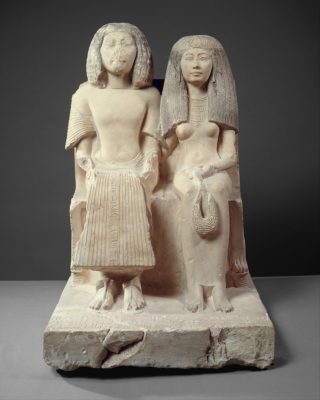The figures in the image represent Yuny seated next to his wife Renenutet. Yuny, lived in the city of Asyut, was a chief royal scribe and holder of many other offices, perhaps including that of physician. On the center fold of Yuny’s pleated skirt is an inscription that reads: “May everything that comes forth upon the offering table of [the god] . . . and all pure food that comes forth from the Great Enclosure [the temple complex at Heliopolis] be for the chief scribe, royal scribe of letters, Yuny, justified.”
“He who loved clothes lies in the cast-off garments of yesterday.” So reads an ancient Egyptian funerary lament.
Dress played a major role in the eternal world of the ancient Egyptians. In life and in death, cloth and garments were considered to be one of the most important components of a person’s life. Indeed, the world’s oldest dress comes from a large mastaba of the First Egyptian Dynasty, and King Tutankhamun’s Eighteenth Dynasty tomb, has yielded over 100 garments.
Clothing was not only functional, but was symbolic of a person’s social position. Cloth was highly valued and appeared as a major feature in the list of tomb offerings. Images in tomb paintings, relief and statuary, and the material remains of garments themselves, exhibit a variety of styles which changed over time. Cosmetics, jewelry and other accoutrements were not only ornamental, but were believed to have magical properties attached to them as well.
This presentation will examine transitions in ancient Egyptian fashion from the severe to the flamboyant and the practical to the whimsical. Excavated objects include garments, sandals, mirrors, kohl tubes, cosmetics, razors, wigs, and hair ornaments, and finely crafted jewelry of exquisite beauty and elegance, from the collection of The Metropolitan Museum of Art and beyond.
Phyllis Saretta received her Ph.D from New York University in Egyptology, and Ancient Near East Archaeology and Languages in 1997. She was awarded an Andrew W. Mellon Fellowship in the Department of Egyptian Art at The Metropolitan Museum in 1994-95, where she completed the research for her dissertation which focused on the cultural, social and historical interconnections between Egypt, Mesopotamia and the Levant.
Dr. Saretta has conducted independent research in Egypt at the site of Beni Hasan, and has participated in archaeological fieldwork at the ancient Mesopotamian site of Lagash (Tell al-Hiba) in Southern Iraq where she was a Site Supervisor. She has taught undergraduate courses at The New School University on both Egypt and Mesopotamia, and was a part-time Staff Lecturer and Researcher at the Metropolitan Museum of Art for 19 years. She has published articles in both scholarly journals and popular magazines, such as The Bulletin of the Egyptological Seminar of New York and KMT. Her book, Asiatics in Middle Kingdom Egypt, Perceptions and Reality, was published by Bloomsbury in 2016.


